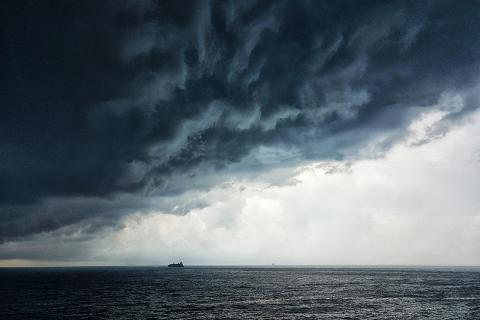The STORMY-WEATHER project will use the latest climate projections from CMIP6 and UKCP18 to develop a new methodology to understand what drives changes in extreme rainfall and windstorms for different storm types. This will produce a set of physically plausible, high impact storm hazard storylines and metrics to enhance future planning.
Approach
The ‘storm-type’ approach will help determine the type and scale of hazard from different rainfall mechanisms and their scaling rates with temperature. It will also seek to understand combined wind and rain hazards brought by storms, as well as their changing nature over time with climate change. Understanding these characteristics is vital for effective planning for flooding and the design of infrastructure, transport and energy systems, amongst others.
The focus on storm properties is balanced against the need to understand the impact of potential changes to large-scale circulation patterns on storm hazards, e.g. changes in frequency or persistence, and, in particular, the possibility of circulation-driven changes to the dominant event type across regions.
Ultimately to make appropriate adaptation decisions, the UK needs accurate and usable information on how extreme weather events might change in the future. STORMY-WEATHER aims to provide this and develop useful tools and metrics to ensure research outputs can be used in impact modelling.
Project objectives
- To characterise the precipitation and wind associated with different storm types over the UK, identified using objective methods (i.e. cyclones, fronts, embedded deep convection).
- To develop event-based metrics based on their precipitation and wind footprints (temporal and spatial signatures) and understand their combined hazard.
- To investigate the relationship between regional and global temperature change and these event-based footprints for different cold season storm types, identifying plausible future storm hazards from ensembles of state-of-the-art climate simulations.
- To produce storylines of plausible footprints of storm hazards for use by stakeholders in impacts models.
Publications
- Fowler H.J., Wasko C., and Prein A.F. 2021. Intensification of short-duration rainfall extremes and implications for flood risk: current state of the art and future directions. Phil. Trans. R. Soc. A. 379: 20190541
- Fowler H.J., Ali H., Allan R.P., et al. 2021. Towards advancing scientific knowledge of climate change impacts on short-duration rainfall extremes. Phil. Trans. R. Soc. A. 379: 20190542
- Moron V., Barbero R., Fowler H.J. and Mishra V. 2021 Storm types in India: linking rainfall duration, spatial extent and intensity. Phil. Trans. R. Soc. A. 379: 20200137
- Lenderink G., de Vries H., Fowler H.J., et al. 2021. Scaling and responses of extreme hourly precipitation in three climate experiments with a convection-permitting model. Phil. Trans. R. Soc. A. 379: 20190544
- Orr H.G., Ekström M., Charlton M. B., Peat K. L. and Fowler H. J. 2021. Using high-resolution climate change information in water management: a decision-makers’ perspective. Phil. Trans. R. Soc. A. 379: 20200219
- Wasko C., Westra S., Nathan R., et al. 2021. Incorporating climate change in flood estimation guidance. Phil. Trans. R. Soc. A. 379: 20190548
- Catto, J. L., Dowdy, A. 2021. Understanding compound hazards from a weather system perspective. Weather and Climate Extremes. 32: 100313.

